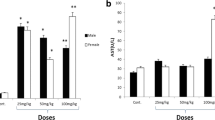Abstract
A single intraperitoneal dose (25 mg/kg) of gossypol given to male Sprague-Dawley rats caused marked changes in the activity of the hepatic and serum γ-glutamyltransferase (GGT) and microsomal monooxygenases. The GGT activity in liver homogenate, S-9 supernatant fraction and microsomes was significantly depressed; however, the level of serum GGT was elevated. While the hepatic glutathione concentration was not greatly changed, the aminopyrine N-demethylase activity and microsomal cytochrome P450 content of the liver were significantly decreased in the treated rats. At necropsy, the livers of the treated rats appeared generally pale with distinct pinpoint foci. Histopathological examination of the liver showed degenerative changes and coagulative necrosis. The results indicate that gossypol is a strong hepatotoxic agent which can produce severe hepatic damage.
Similar content being viewed by others
REFERENCES
Ali, S.F. and El-Sewedy, S.M., 1984. Effect of gossypol on liver metabolic enzymes in male rats. Toxicology Letters, 23, 299-306
Athar, M., Hasan, S.K. and Srivastava, R.C., 1987. Role of glutathione metabolizing enzymes in nickel mediated induction of hepatic glutathione. Research Communications in Chemical Pathology and Pharmacology, 57, 421-424
Chengelis, C.P., 1988. Paradoxical effect of cobaltous chloride on carbon disulfide induced hepatotoxicity in rats. Research Communications in Chemical Pathology and Pharmacology, 61, 83-96
Dalvi, R.R., Hunter, A.L. and Neal, R.A., 1975. Toxicological implications of the mixed-function oxidase catalyzed metabolism of carbon disulfide. Chemico-Biological Interactions, 10, 347-361
Dalvi, R.R., Whittiker, M.B. and Patil, R.D., 1994. Changes in the hepatic and serum gamma-glutamyl transferase activity in rats and chickens given dietary captan. International Journal of Animal Sciences, 9, 279-281
Dawai, K.R., Cox, C., Jackson, J. and Dalvi, R.R., 1995. Changes in the activity of metabolic and non-metabolic liver enzymes in rats following co-administration of gossypol with phenobarbital. Pharmacology and Toxicology, 76, 289-291
Haschek, W.H., Beasley, V.R., Buck, W.B. and Finnell, J.H., 1989. Cottonseed meal (Gossypol) toxicosis in a swine herd. Journal of the American Veterinary Medical Association, 195, 613-615
Jollow, D.J., Mitchell, J.R., Zampaglione, N. and Gillette, J.R., 1974. Bromobenzene-induced liver necrosis: protective role of glutathione and evidence for 3,4-bromobenzene oxide as the hepatotoxic metabolite. Pharmacology, 11, 151-169
Lee, C.Y., Moon, Y.S., Yuan, J.H. and Chen, A.F., 1982. Enzyme inactivation and inhibition by gosspol. Molecular and Cell Biochemistry, 47, 65-70
Ma, X.N. and Black, D.J., 1984. Inhibition of hepatic microsomal enzymes by gossypol in the rat. Contraception, 30, 89-97
Misslbeck, N.G., Campbell, T.C. and Roe, D.A., 1986. Increase in hepatic gamma-glutamyl transferase (GGT) activity following chronic ethanol intake in combination with a high fat diet. Biochemical Pharmacology, 35, 399-404
Moh, P.P., Li, P.K., Darby, M.V., Brueggemeier, R.W. and Lin, Y.C., 1992. Characteristics of covalent gossypol binding to microsomal proteins. Research Communications in Chemical Pathology and Pharmacology, 76, 305-322
Morgan, S.E., 1989. Gossypol as a toxicant in livestock. Veterinary Clinics of North America: Food Animal Practice, 5, 251-262
Omura, T. and Sato, R., 1964. The carbon monoxide binding pigment of liver microsomes. I. Evidence for its hemoprotein nature. Journal of Biological Chemistry, 239, 2370-2378
Roomi, M.W. and Goldberg, D.M., 1981. Comparison of gamma-glutamyl transferase induction by phenobarbital in the rat, guinea pig and rabbit. Biochemical Pharmacology, 30, 1563-1571
Rosalki, S.B., 1975. Gamma-glutamyl transpeptidase. Advances in Clinical Chemistry, 17, 53-107
Rosenberg, L.J., Adlakha, R.C., Desai, D.M. and Rao, P.N., 1986. Inhibition of DNA polymerase alpha by gossypol. Biochimica et Biophysica Acta, 866, 258-267
Schenkman, J.B., Remmer, H. and Estabrook, R.W., 1967. Spectral studies of drug interaction with hepatic microsomal cytochrome. Molecular Pharmacology, 3, 113-123
Wang, Y. and Lei, H.P., 1987. Hepatotoxicity of gossypol in rats. Journal of Ethnopharmacology, 20, 53-64
Author information
Authors and Affiliations
Rights and permissions
About this article
Cite this article
Deoras, D., Young-Curtis, P., Dalvi, R. et al. Effect of Gossypol on Hepatic and Serum γ-glutamyltransferase Activity in Rats. Vet Res Commun 21, 317–323 (1997). https://doi.org/10.1023/A:1005856119553
Issue Date:
DOI: https://doi.org/10.1023/A:1005856119553




